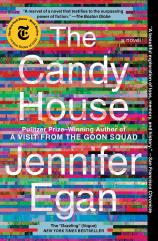Reading Group Guide
Discussion Questions
The Candy House

1. In nearly every chapter of THE CANDY HOUSE, characters are in disguise or turn out to be connected to other characters in unexpected ways, or are seen from different perspectives, or are simply strangers to themselves. Talk about Jennifer Egan’s exploration of knowability: how we know ourselves and how others know us.
2. In the first chapter, Bix, disguised as a graduate student, tries to recreate the kinds of discussions he remembers having as a college and graduate student. Why are these dialogues so hard for him to have in his adult life? And how essential is his disguise to the revelation and discovery that follow?
3. THE CANDY HOUSE is made up of stories written in distinct narrative voices and styles. How do these different approaches affect your reading experience? Did you feel a kind of spark when you recognized where the characters’ lives intersected?
4. THE CANDY HOUSE is broken into four sections --- “Build” (twice), “Break” and “Drop” --- mimicking the structure of Electronic Dance Music. How do the events of each section fulfill its role in this structure, and how do the sections relate to each other? Discuss why the author might have chosen to organize her book this way.
5. Seeking authenticity is a core theme of THE CANDY HOUSE. According to Alfred Hollander, authenticity requires “violent unmasking” (page 30), which is why he uses disruptive behavior, such as screaming in public, to produce unfiltered reactions. What do you make of Alfred’s philosophy? Does technology like social media lead to less authentic communication and experience? What are the limitations of Alfred’s solutions?
6. If the “Own Your Unconscious” technology were real, would you use it? What are its advantages and disadvantages? Are elements of Own Your Unconscious already present in the internet? Would you externalize your memories to the Collective Consciousness, or would you become an eluder...or something in between?
7. Miles Hollander is a mystery to himself. He is baffled by the differing outcomes in his own life and his cousin Sasha’s. Yet when he goes up in a hot air balloon and sees Sasha’s artwork from above, everything comes into perspective for Miles --- both his cousin’s sculptures and his life. Talk about Miles’ discovery, and how and why distance --- and art --- help him to make it. What kept him from seeing things clearly before?
8. Data experts are called “counters” in THE CANDY HOUSE. For some, like Lincoln, being a counter is not just a job but an identity --- counters are hyperanalytical people who “understood numbers before...language” (page 81). What perspective do we gain by breaking down the human experience into data? And where does the mystery of human experience lie --- the part that data cannot describe? Is it possible to reconcile those two realties?
9. Throughout “Rhyme Scheme,” Lincoln refers to “empiricists” and “impressionists.” How does he describe these two groups? And how accurate do these categories really seem to be, both in this chapter and throughout the novel?
10. In “Bright Day,” Roxy watches a Dungeons & Dragons game each week at her drug treatment center. She marvels at how characters are created and how players become absorbed in the game. What role does D&D play in telling Roxy’s own story? How do her observations on the game apply to the other characters’ experiences in the novel?
11. “Proxies” are professionals who cover up for eluders by maintaining their abandoned identities online. Most proxies are fiction writers who impersonate multiple identities at once. Think about why someone might become a proxy. Would you? What is the significance of fiction writers taking such a job? Are all novelists proxies of a sort?
12. Across the novel, we see characters through several perspectives, including their own. We see them through the eyes of those who are close to them and those who only know them slightly. What do you make of this holistic view? What might you learn if you could see yourself in this way --- and would you want to? What does this storytelling approach allow Egan to do that she might not be able to, using a more traditional structure?
13. “Lulu the Spy, 2032” and “See Below” use the two most unusual narrative styles in the novel. Why do you think Egan chose to approach these particular chapters as she did? Imagine that these stories were told in a more conventional format. What would be lost?
14. In “Eureka Gold,” we learn of the tension and conflict between Bix Bouton and his youngest child, Gregory. What is the nature of the gulf between them? And how does their father-son tension reflect the larger concerns in THE CANDY HOUSE? What do you make of Gregory’s final discoveries in this chapter --- about his father and about himself?
15. The novel ends with the story of Ames Hollander, age 11, hitting a home run and winning the baseball game for his team in 1991. Why do you think Egan chose to end the novel with a story set before most of the inventions and the action take place? What role does technology play in the final chapter, and how does it reflect back on the rest of the stories leading up to it?
16. Own Your Unconscious doesn’t exist in the real world --- yet. Or does it? How is life with Bix’s invention different from the virtual world we already live with? And what does Egan suggest in the final chapter about the role of fiction in our experience of the collective unconscious?
17. If you have already read A VISIT FROM THE GOON SQUAD or you go back to it after reading THE CANDY HOUSE, what do you think about the way Egan moves the central protagonists from GOON SQUAD to the periphery in this novel, and gives minor characters (a couple of them not yet born in GOON SQUAD) major roles here?
The Candy House
- Publication Date: March 7, 2023
- Genres: Fiction
- Paperback: 368 pages
- Publisher: Scribner
- ISBN-10: 1476716773
- ISBN-13: 9781476716770







